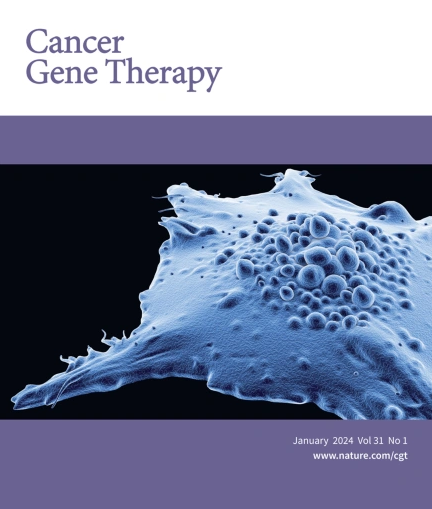BAIAP2L2通过靶向jak1介导的途径和PD-L1表达促进肝细胞癌的进展和免疫逃避。
IF 5
3区 医学
Q1 BIOTECHNOLOGY & APPLIED MICROBIOLOGY
引用次数: 0
摘要
肝细胞癌(HCC)因其高致死率对人类健康构成严重威胁。近年来,免疫治疗领域取得了突破性进展。然而,HCC进展和免疫逃逸的机制尚不清楚。本研究旨在探讨脑特异性血管生成抑制剂1-相关蛋白2-样2 (BAIAP2L2)在HCC中的作用,并阐明其潜在机制。临床资料显示,在HCC患者中,BAIAP2L2过表达与肿瘤进展及预后不良相关。功能分析表明,BAIAP2L2在体外和体内均能促进HCC的增殖、转移、侵袭和pd - l1介导的免疫逃避。在机制上,我们观察到BAIAP2L2和JAK1在HCC细胞内共定位和相互作用,进而增强JAK1/STAT3信号通路的激活。利用JAK1抑制剂Ruxolitinib有效逆转baiap2l2诱导的细胞过程,如增殖、迁移、侵袭和PD-L1上调。总之,我们的研究结果强调了BAIAP2L2通过jak1介导的信号通路在HCC中驱动肿瘤进展和免疫逃避中起着至关重要的作用,因此提出了BAIAP2L2作为HCC治疗的有希望的治疗靶点。本文章由计算机程序翻译,如有差异,请以英文原文为准。

BAIAP2L2 facilitates hepatocellular carcinoma progression and immune evasion of via targeting JAK1-mediated pathway and PD-L1 expression
Hepatocellular carcinoma (HCC) poses a serious threat to human health due to its high mortality rate. Recently, breakthrough progress has been made in immunotherapy field. However, the mechanisms underlying HCC progression and immune escape are still unclear. This study aimed to investigate the impact of brain-specific angiogenesis inhibitor 1-associated protein 2-like 2 (BAIAP2L2) in HCC and elucidate its potential mechanisms in this context. Clinical data revealed that the overexpression of BAIAP2L2 correlated with tumor progression and poor prognosis in HCC patients. Functional assays demonstrated that BAIAP2L2 facilitates HCC proliferation, metastasis, invasion, and PD-L1-mediated immune evasion both in vitro and in vivo. Mechanistically, we observed co-localization and interaction between BAIAP2L2 and JAK1 within HCC cells, in turn enhancing the activation of the JAK1/STAT3 signaling pathway. Utilizing the JAK1 inhibitor Ruxolitinib effectively reversed BAIAP2L2-induced cellular processes such as proliferation, migration, invasion, and PD-L1 upregulation. Overall, our results emphasize that BAIAP2L2 plays a crucial role in driving tumor progression and immune evasion in HCC through the JAK1-mediated signaling pathway, thus proposing BAIAP2L2 as a promising therapeutic target for HCC treatment.
求助全文
通过发布文献求助,成功后即可免费获取论文全文。
去求助
来源期刊

Cancer gene therapy
医学-生物工程与应用微生物
CiteScore
10.20
自引率
0.00%
发文量
150
审稿时长
4-8 weeks
期刊介绍:
Cancer Gene Therapy is the essential gene and cellular therapy resource for cancer researchers and clinicians, keeping readers up to date with the latest developments in gene and cellular therapies for cancer. The journal publishes original laboratory and clinical research papers, case reports and review articles. Publication topics include RNAi approaches, drug resistance, hematopoietic progenitor cell gene transfer, cancer stem cells, cellular therapies, homologous recombination, ribozyme technology, antisense technology, tumor immunotherapy and tumor suppressors, translational research, cancer therapy, gene delivery systems (viral and non-viral), anti-gene therapy (antisense, siRNA & ribozymes), apoptosis; mechanisms and therapies, vaccine development, immunology and immunotherapy, DNA synthesis and repair.
Cancer Gene Therapy publishes the results of laboratory investigations, preclinical studies, and clinical trials in the field of gene transfer/gene therapy and cellular therapies as applied to cancer research. Types of articles published include original research articles; case reports; brief communications; review articles in the main fields of drug resistance/sensitivity, gene therapy, cellular therapy, tumor suppressor and anti-oncogene therapy, cytokine/tumor immunotherapy, etc.; industry perspectives; and letters to the editor.
 求助内容:
求助内容: 应助结果提醒方式:
应助结果提醒方式:


